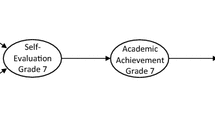Abstract
Many studies concur that students’ perceptions of their home and school environments, such as relationships with parents and teachers, are related to their academic self-concept (for example, Chang et al., Int J of Behav Dev 27(2):182–189, 2003; Ireson and Hallam, Br J Educ Psychol 75:297–311, 2005; Jang, J Kor Home Econ, 39:101–114, 2001; Lau and Leung, Br J Educ Psychol, 62:193–202, 1992; Lau and Pun, Social Behav Pers, 27(6):639–650, 1999; Masche and Barber, “Connectedness and separation in parent-adolescent relationships: Indicators of a successful identity development.” Paper presented at the SRCD Biennial Meeting, Minneapolis, MN, April 19–22, 2001; Sanders, “School–family–community partnerships and the academic achievement of African American, urban adolescents.” Report No. 7. EDRS. ED 402404, 1996). Nonetheless, little is known about whether the strength of the relationships is comparable for students of different ability streams, or if the predictors of variance of their academic self-concept are similar. To fill the empirical gap, a 3-year longitudinal study was conducted with Secondary One students (approximate age 13) from three government schools in Singapore. Pearson product–moment correlation and Fisher’s z r transformation showed that there were significant differences in the strength of the relationships between higher- and lower-ability stream students’ academic self-concept and their perceived home environment and classroom climate. In addition, stepwise multiple linear regressions established that lower-ability stream students’ perceived teachers’ expectations had more consistent and substantial impact on their confidence level than that of their higher-ability stream counterparts. In comparison, higher-ability stream students’ perceived parental academic support had more consistent impact on their academic self-concept than that of their lower-ability stream peers.




Similar content being viewed by others
References
Battle, J. (1981). Culture-free SEI: Self-esteem inventories for children and adults. Seattle: Special Child Publications.
Chang, L., McBride-Chang, C., Stewart, S., & Au, E. (2003). Life satisfaction, self-concept, and family relations in Chinese adolescents and children. International Journal of Behavioural Development, 27(2), 182–189.
Claes, M. (1998). Adolescents’ closeness with parents, siblings, and friends in three countries: Canada, Belgium and Italy. Journal of Youth and Adolescence, 27(2), 165–184.
Cooley, C. H. (1912). Human nature and the social order. New York: Scribners.
Dacey, J., & Kenny, M. (1997). Adolescent development (2nd ed.). Boston: McGraw-Hill.
Hoelter, J., & Harper, L. (1987). Structural and interpersonal family influences on adolescent self-conception. Journal of Marriage and the Family, 49, 129–139.
Ireson, J., & Hallam, S. (2005). Pupils’ liking for school: Ability grouping, self-concept and perceptions of teaching. British Journal of Educational Psychology, 75, 297–311.
James, W. (1890). Principles of psychology. New York: Holt, Rinehart and Winston.
Jang, Y. (2001). An analysis of the children’s perceived competence and the related variables. Journal of Korean Home Economics, 39, 101–114.
Juhasz, A. M. (1989). Significant others and self-esteem of American and Australian early adolescent. EDRS Price. ED 340963.
Juhasz, A. M., & Yue, M. (1989). Significant others of U.S. white, black and Chinese early adolescents: EDRS Price. ED 340962.
Lau, S., & Leung, K. (1992). Relations with parents and school and Chinese adolescents’ self-concept, delinquency, and academic performance. British Journal of Educational Psychology, 62, 193–202.
Lau, S., & Pun, K. (1999). Parental evaluations and their agreement: Relationship with children’s self-concepts. Social Behaviour and Personality, 27(6), 639–650.
Lempers, J. D., & Clark-Lempers, D. S. (1992). Young, middle, and late adolescents’ comparisons of the functional importance of five significant relationships. Journal of Youth and Adolescence, 21(1), 53–96.
Leonardson, G. R. (1986). The relationship between self-concept and selected academic and personal factors. Adolescence, 21(82), 467–474.
Liu, W. C. (1994). Academic self-concept in a streamed setting: Home environment and classroom climate factors. Unpublished M.Ed. Dissertation, University of Nottingham, England.
Liu, W. C., & Wang, C. K. J. (2005). Academic self-concept: A cross-sectional study of age and gender differences in a Singapore secondary school. Asia Pacific Education Review, 6(1), 20–27.
Liu, W. C., Wang, C. K. J., & Parkins, E. (2005). A longitudinal study of students’ academic self-concept in a streamed setting: The Singapore’s context. British Journal of Educational Psychology, 75(4), 567–586.
Marsh, H. W., & Parker, J. (1984). Determinants of student self-concept: Is it better to be a relatively large fish in a small pond even if you don’t learn to swim as well? Journal of Personality and Social Psychology, 47, 213–231.
Marsh, H. W., Relich, J. D., & Smith, I. D. (1983). Self-concept: The construct validity of interpretations based upon the SDQ. Journal of Personality and Social Psychology, 45, 173–187.
Masche, J. G., & Barber, B. K. (2001). Connectedness and separation in parent-adolescent relationships: Indicators of a successful identity development. Paper presented at the SRCD Biennial Meeting, Minneapolis, MN, April 19–22.
Mead, G. H. (1934). Mind, self and society. Chicago: University of Chicago Press.
Moos, R. H., & Trickett, E. J. (1974). Classroom environment scale manual. Palo Alto: Consulting Psychologists Press.
Piers, E. V., & Harris, D. B. (1964). Age and other correlates of self-concept in children. Journal of Educational Psychology, 55(2), 91–95.
Sanders, M. G. (1996). School–family–community partnerships and the academic achievement of African American, urban adolescents. Report No. 7. EDRS. ED 402404.
Schunk, D. H., Pintrich, P. R., & Meece, J. L. (2002). Motivation in education: Theory, research, and applications (3rd ed.). New Jersey: Pearson Merrill-Prentice Hall.
Acknowledgements
Data for the present study were part of a longitudinal study looking at the effects of sex, stream and age on students’ academic self-concept and their perceptions of home and school environments. Permission for the study was granted to the first author by the Ministry of Education, Singapore (ESS/95/12).
Author information
Authors and Affiliations
Corresponding author
Rights and permissions
About this article
Cite this article
Liu, W.C., Wang, C.K.J. Home Environment and Classroom Climate: An Investigation of their Relation to Students’ Academic Self-Concept in a Streamed Setting. Curr Psychol 27, 242–256 (2008). https://doi.org/10.1007/s12144-008-9037-7
Published:
Issue Date:
DOI: https://doi.org/10.1007/s12144-008-9037-7



